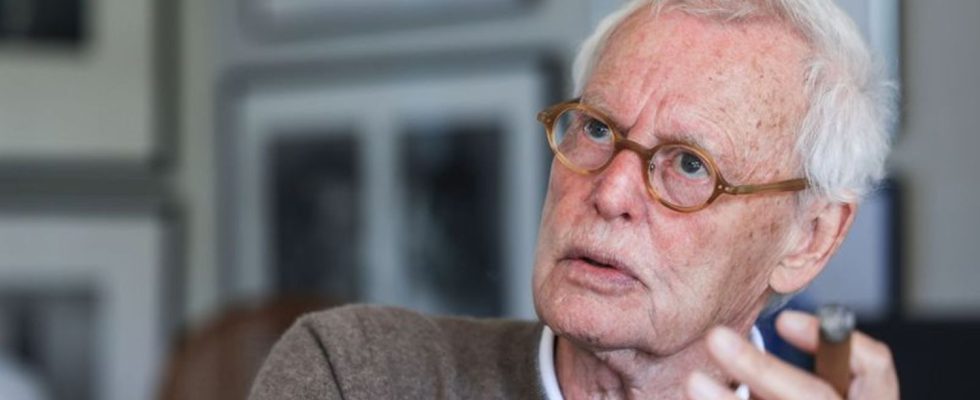photography
The ironic eye of Olaf Scholz
Portrait photographer Konrad Rufus Müller in his living room: He has photographed every German chancellor since Adenauer. photo
©Oliver Berg/dpa
Konrad Rufus Müller has photographed every Federal Chancellor since Konrad Adenauer. With some he never found a connection, with others he experienced historic moments. One in particular impressed him.
Olaf Scholz, the impenetrable, looks attentively but not strained. If you look closely, his left eye is a little smaller, giving him a slightly ironic expression. Overall, he seems unusually relaxed, which is probably due to the fact that his neck is not constricted by a tie and shirt collar – he is wearing a sweater. The photo was taken in November last year in the Federal Chancellery. Konrad Rufus Müller did it. The 83-year-old has photographed every Federal Chancellor, from Konrad Adenauer on.
His images differ from other portrait photographs. They are more intense – one thinks one can recognize the person behind them. That, says Müller, comes from the fact that he has accompanied some chancellors over many years and was thus able to observe them in special, also personal moments, in which they were no longer aware of his presence. In other cases, on the contrary, it stems from the very fact that it only took a few minutes. For a brief moment, he says, leaders might be willing to snuggle up to a photographer and really look them in the eye. “Then they get bored and annoyed very quickly – and you can see that in their eyes.”
Analog – not digital
Müller always takes very few pictures. He still photographs analogue, not digital. He has only used two cameras in his entire life. The first of these, built in 1936, came from his father. He also never brings headlights, tripods or other accessories. Just his little camera. For this, he says, he was often ridiculed.
Müller, who was born in Berlin, lives in a bungalow with a garden full of fruit trees in Königswinter near Bonn. Sunlight streams in from outside and illuminates the large living room table. There Müller has spread a selection of his chancellor pictures. It’s a journey back in time to the 1960s.
There is the unmistakable face of Konrad Adenauer, with the flat nose and high cheekbones, seemingly shaped by the ups and downs of a long political life. In the close-up of Müller you can see every crease, every stain. Müller was only in his mid-20s when he was allowed to accompany Adenauer to a CDU party conference and a few other appointments. At the time, the first chancellor of the Federal Republic seemed like a demigod to him. But he was by no means unapproachable. When Adenauer walked down the steep path from his home in Rhöndorf near Bonn unaccompanied, only his driver and a single security officer were waiting below. “You could shake hands with Adenauer and talk to him. Unthinkable today.”
Müller: “Willy Brandt was my hero.”
The other two CDU chancellors of the post-war years, Ludwig Erhard and Kurt Georg Kiesinger, followed, and then the legendary Willy Brandt. You can see from Müller’s photos which personalities really impressed him – in addition to Adenauer, this was above all the first SPD chancellor. “Willy Brandt was my hero.” He developed such a close relationship with him that he even visited him on vacation in Norway. By then, however, Brandt had already resigned. In Müller’s pictures one believes to recognize the inner turmoil and the strong mood swings of the at times severely depressed hope of a whole generation.
The cool Helmut Schmidt left Müller cold, unlike his successor, Helmut Kohl, who was so ridiculed at first. He accompanied him on 52 trips abroad and experienced him in historical hours. For example, when Kohl took a walk with Mikhail Gorbachev through the garden of the Chancellor’s bungalow in Bonn in the summer of 1989. The colossal Kohl stands in front of Gorbachev with his arms raised, as if he were acting out a theatrical scene for the Soviet head of state and party. Müller later asked Kohl what he said to Gorbachev at that moment, but he did not tell him.
In January 1990, Müller was there when Kohl visited François Mitterrand at his home on the Atlantic coast south of Bordeaux. Müller was allowed to come along because he had previously made a photo book about and with the French President and spoke fluent French. Until then, Mitterrand, like British Prime Minister Margaret Thatcher, had been strictly against a unification of the two German states. Müller remembers: “We then drove from Mitterrand’s house to the beach, and there Kohl talked to him for an hour in the parked car. Afterwards on the plane he said that was the moment when he turned him around and took him away convinced that there was no getting around unity.”
Two minutes with Angela Merkel
Kohl later resented him for establishing good contact with his SPD successor, Gerhard Schröder. On the other hand, he only got Angela Merkel briefly in front of the camera once. “Two minutes, that wasn’t longer.”
Müller has realized countless other photo projects in his life as a freelance photographer. His life’s work consists of a total of 2800 unique photos that he would like to bequeath to a museum. Above all, the chancellor pictures are likely to survive. He hopes that in 2024 there will be an illustrated book and an exhibition to mark the 75th anniversary of the Federal Republic of Germany. Olaf Scholz has already agreed to act as patron, says Müller. “I would like to experience that.”

